
|
 |

|
 |
Ratikant Mohapatra: An obsession with perfection - Lalitha Venkat, Chennai e-mail: lalvenkat@yahoo.com Photos courtesy: Srjan September 17, 2010 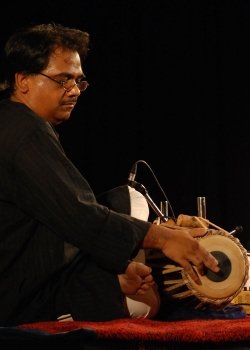
Ratikant performing Mardala recital Ratikant Mohapatra has carved for himself an enviable niche as a dancer, percussionist, teacher and archivist. In the last 25 years, together with his father Guru Kelucharan Mohapatra, he has been able to establish a firm imprint of Odissi in the consciousness of audiences in India and abroad. Drawing on a vast reservoir of creative talent found abundantly in father Guru Kelucharan Mohapatra and mother Laxmipriya, the young Ratikant was more in love with percussion than the schoolbook, and rapidly evolved into a masterful player of the Odissi 'Mardala' and a leading male dancer to adorn the stage by the age of 16. The stamp of the Kelucharan Gharana is evident in Ratikant's soft and hypnotic style of playing the Mardala - the priceless inheritance from Guru Kelucharan Mohapatra himself. From a young age, he collected a string of accolades for his dual skills, demonstrating them with a typical ease and flair in numerous stage performances, and workshops in India and abroad. He rendered enthusiastic and invaluable support to Guru Kelucharan Mohapatra in organizing, performing and assisting Guruji in the 1980's when he traveled abroad frequently to establish a global presence for the dance that represents today, the acme of Oriya cultural heritage and its dynamic evolution. As the Director of Srjan (Guru Kelucharan Mohapatra Odissi Nrityabasa), he has created a world-class dance institute, which attracts students from all over the globe for extended periods of learning Odissi dance. Added to this, Ratikant organises regular summer workshops for senior students and beginners to help them absorb the subtle and nuanced dance that has been fashioned by the Guru Kelucharan Gharana in Odissi. He has choreographed more than 30 new Odissi items, hailed for innovation and quality music. They are 'Jatayu Mokshya', 'Allah', 'Tarana Pallavi', 'Suna Manna', 'Bhaja Govindam', 'Om', 'Gita Govinda', 'Charukeshi Pallavi' (in the 9-beat Adda tala), 'Mrutyu' and the latest 'Tantra' to name a few. Ratikant derives his inspiration from long years of observing Guru Kelucharan Mohapatra choreograph new pieces and tirelessly work them until the last little detail is perfected. His perfectionism and his uncompromising attention to the minutest detail mirrors his Guru's sense of style and sensitivity to the ambience created by the dance, the music, and the dancer. After conducting the very successful 16th Kelucharan Mohapatra Award Festival recently in Bhubaneswar, Ratikant Mohapatra talks to narthaki.com about the festival, his father and the Odissi dance form. 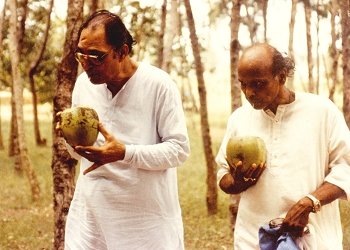
Pt. Bhubaneswar Mishra Guru Kelucharan Mohapatra 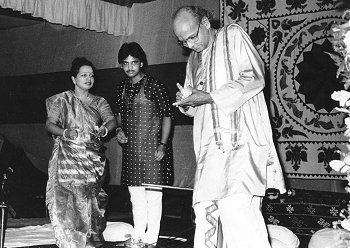
Sudha Dutt, Ratikant in centre, and Guruji acting in a Hindi play 'Aadaab' LV: What was the motivation for you to institute the Guru Kelucharan Mohapatra Award? RKM: There is no single answer to this question. Paramount among the many initiatives closest to Guruji's heart was the annual "Guru Kelucharan Mohapatra Award". As anybody (who knew him closely 30 years ago) would tell you, Guruji had a deep concern for fellow artistes who like him came from impoverished backgrounds but continued on their creative journey - in folk theatre, stage theatre, classical dance, and even in cinema. It is important to note that there was hardly any financial support from the Establishment, even though the Orissa Govt. did recognize and honour his lifelong work in the Arts. Guruji was a "Patachitra painter", a dancer / percussionist, a stage actor as well as a choreographer for film sequences (also a day labourer and a mason as a young man). It was thus natural on my part to institute an annual award framework which gave due importance to meritorious people from these 4 creative fields - Dance, Music, Theatre and Cinema. Guruji's great gift to me was to implant in me a hunger for excellence in classical dance, percussion and the attendant music. I continued to work hard for the success of the "Guru Kelucharan Mohapatra Award Festival" out of the need to repay the debt of gratitude to Guruji and a number of other contemporary stalwarts whose work and great enthusiasm keeps on providing me with the necessary momentum. Among them are the great Pt. Bhubaneswar Mishra, Pt. Raghunath Panigrahi, Sanjukta Panigrahi, Rakhal Mohanty, Pt. Birju Maharj, Pt. Jasraj, Girija Devi, Shyamanand Jalan and Mahant Maharaj ji Sri Veer Bhadra Mishra of Varanasi (Sankat Mochan Music & Dance festival). As has been mentioned in the vision statement of Guru Kelucharan Mohapatra Award, "The underlying principle of this award is also to generate a fellow feeling amongst the performing artistes who can, individually and severally, focus all their energies into taking their art to splendid heights, through mutual consultation and collaboration." LV: Now that this is the 16th year the award has been bestowed, do you have any specific plans for forthcoming years? RKM: Yes. It will be my constant endeavour to take the Award festival to even greater heights that it has already reached in the last 16 years. In spite of the increasing difficulties of sourcing funds for a festival of this status and size, I would like to broaden the scope of the award framework to include notable awardees from outside the State. There will be of course, concurrently, awards for deserving artistes from Odisha. I dream of the day when the award amount will be big enough to be of real help to the recipient and the performance quality in the Award function, per se, will match the finest classical festivals of India. My people at Srjan and I have already covered quite some distance on this particular journey. LV: How do you select the artistes to perform at the GKMA Fest? The artistes of the 3 days I saw were all performing for the first time at Bhubaneswar. RKM: We try to provide a mix of famous performers and some relatively new names who are all artistes of quality. The idea is to showcase artistes whom our Odisha audience has not yet tasted, both established and budding artistes. Apart from the obvious novelty of a star performer, the added benefit is to a new generation of dance and music students who get a direct exposure to artistes that they have only heard about. Plus, we take care in designing each evening's performance with an eye on the most suitable combination of artistes and genre. LV: You conduct around 4 major festivals every year. How do you manage the funding? RKM: That question hurts where it pinches!! Since there are relatively few reputed industrial houses in Odisha (compared to metro cities and other States) and since the sparse Govt. funding for performing arts has to be thinly distributed, our work in raising funds is getting increasingly burdensome. However, the goodwill that Guru Kelucharan Mohapatra earned in his lifetime, both with his art and his personal warmth, has helped us to at least make an optimistic approach to both Govt. agencies as well as industrial houses which are beginning the activities here. There are of course a few loyal sponsors, both financial as well as media sponsors, who have ensured that we are able to mount these 4 festivals every year with a degree of success. These festivals are "Guru Kelucharan Mohapatra Award Ceremony", "Marga Darshan (GKCM Purush Dance Festival meant exclusively to present male dancers), "Samsmaranam (held to mark Guruji's death anniversary)" and "Deesha festival" at Kolkata (held under the aegis of Guru Kelucharan Mohapatra Yuva Prativa Samman), which provides a much needed platform for young dancers 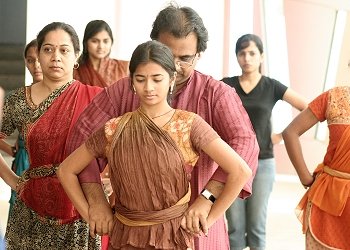
Ratikant conducting a workshop during Dance Jathre at Bangalore 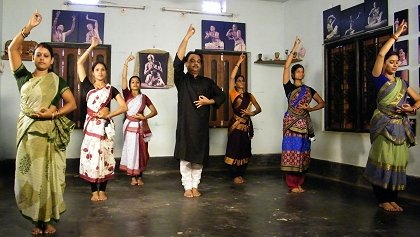
Ratikant teaching at Srjan LV: You are the torchbearer of your father's tradition. How heavily does it weigh on you? RKM: Interesting question though a difficult one. Guruji was a kind of man who liked to nurture everything and everyone around him, a giant shade-giving tree which protected as it nurtured. As a son, the artistic and emotional nourishment that I have received has helped me to take on the entire burden after his untimely passing. Also the way he looked at art, dance, people, issues, Life - has taught me to take each passing day seriously, to learn a lesson from mistakes made, and to look at dance and music as a very rich and indispensible aspect of our lives. We try to run Srjan as he would have done himself if he were here; we also try to look at new work and new choreography with the acuity of vision that he tried to develop in us. One is grateful for so many things! And being his son has been much more of a valued gift than anything else. If I can carry on his rich legacy of teaching and performing with the excellence that he demanded of us, I will be more than happy. There is indeed a small cloud to this silver lining! It has been very occasionally felt by a few that in new choreography, I might have veered away from a traditional Odissi style of the past compositions done by Guruji. People who make such remarks have not noticed that Guruji was a great innovator himself! There are countless examples where a few deft and subtle touches introduced by Guruji have enormously brightened traditional choreography. In fact, the courage to do something new has been inspired by him and his very fresh approach to fresh and unfamiliar ideas. So it does irk a little when people sit in judgment without seriously looking at the thought and the intensity that has gone into new work. If anybody has to be blamed for being innovative, it is Guruji. And he would have welcomed such criticism! LV: Do you think, at times, the popularity of the Kelucharan Mohapatra tradition eclipses the contribution of other gurus of the Jayantika movement? RKM: At a critical time in the revival of classical Odissi dance, Guruji's distinct way of looking at the finer aspects of dance, Guruji's detailed approach to research, Guruji's painstaking and rigorous teaching method and Guruji's own excellence of performance (both as dancer and percussionist), all created a lot of excitement among a batch of young dancers who carried Guruji's style to many parts of India and the world and themselves became star performers of classical Odissi. Sanjukta Panigrahi, Kumkum Mohanty, Sonal Mansingh to name just a few. When I think back on those days, I am convinced that it was a combination of various factors that made Guruji's work, as performer and teacher, so popular worldwide, with Guruji being the most central factor in all this. The Jayantika movement was a step in the right direction and came at the right time! Jayantika did indeed focus a lot of good energy into the revival of dance and music. If Guruji has received worldwide acclaim for his work and his disciples' work, it has been well deserved. Dancers, choreographers, host organizations - they did feel the intensity of the man. 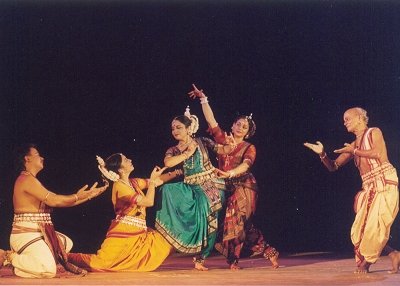
Guruji with Ratikant and his Mumbai disciples performing 'Prema Bhakti' 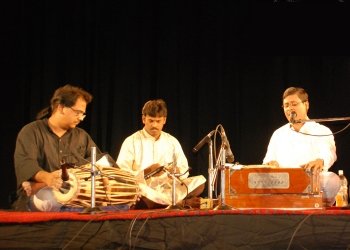
Ratikant accompanying an Odissi vocal recital LV: I am told, some think the present experimentation of some dancers with the Odissi form is resulting in dilution of the traditional Odissi. Your comments. RKM: Experimentation does not necessarily mean dilution. Any innovation within the framework of Odissi classicism can be considered legitimate if care has been taken by the choreographer to leave the basic Odissi structure undisturbed. At the end of the performance, we need to see if the Odissi flavor was there or missing! The Bengapatia, the beautiful Odissi costume, the typical sound of Mardala, the distinctive stances and bends of traditional Odissi - these are some of the indispensible constituents of an Odissi performance. I would not do without them. A deep understanding of the style and the grammar of traditional dance are good enough guideposts to prevent a choreographer from straying into uncharted waters. LV: Do you think it's of added value for an Odissi dancer to also learn to play the Mardala? RKM: Definitely yes. A dancer's skill is hugely enhanced if she/he has a solid sense of laya. Basic knowledge of Mardala helps in this. I believe that even if a person is not born with a sense of laya, it is certainly possible to develop it with some solid work on the intricacies of percussion. While dancers know tala, a perfect sense of laya is quite another thing. And the Odissi tala structure is interestingly complex. Yes, a good dancer needs to have done some work on classical percussion. Since I am both a Mardala player and dancer, my perspective of dance and dance creativity through the eyes of a percussionist has certainly become much sharper. Another big advantage is that a dancer can communicate far more effectively with the Mardalika by remembering bol sequences which have been attractive! Instead of referring to such bols in vague and inefficient ways! The need for good communication between the dancer and the Mardalika is paramount. Even more important is the possession of good sense of laya. It is amazing to discover that a number of so called 'good dancers', even those who are internationally popular, suffer from a debilitating weakness of laya capability. LV: Do you feel Odissi is flourishing well outside India? RKM: Yes, and it is a happy development for Odissi. With more and more Odissi troupes performing in a number of international platforms, the growing popularity of Odissi has earned not only respect for the dancers but has also brought a sense of accomplishment and joy. The cultural exchanges between India and other countries have created ripples of excitement as well as interest in traditional Indian dance and music. Odissi has had its own share of positive benefits from the international enthusiasm for this beautiful dance form. And enquiries keep coming almost every week. 
Guruji & Ratikant at a TV interview 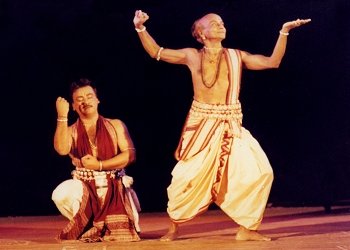
Ratikant performing Ramayan with Guruji LV: What are the values you have imbibed from your father? RKM: An obsession with perfection. Like him, I am happy to work tirelessly, often losing sense of time till every nuance of every movement, till every tone and chord of music settles comfortably with the dance. Guruji had advised me to be intoxicated by the dance and not merely look at the "professional" aspects. Time and certain amount of success have borne out the wisdom of his words. LV: What are your fondest memories of him? RKM: Guruji had an endearing habit of forgetting names! Even mine at times! One winter evening (December 1991) during a stage rehearsal of the popular dance ballet Chandrabhaga (Konark Dance Festival) in the evocative setting of the Sun temple at Konark, Guruji started yelling for a non-existent "Gopal". I (as Madana) was rehearsing a sequence with Sanjukta Panigrahi who had the role of Surya. Out of the blue came a resounding slap on my back and I turned to find a furious Guruji admonishing me for not responding to his many calls for "Gopal"! My nickname is Shibu and by no stretch of the imagination could it be confused for Krishna's nom de plume. When Sanjukta-ji remonstrated that Guruji had forgotten his own son's name, he was hardly repentant! Before turning away, he announced grandly that everyone on stage must be totally attentive! Till now I am quite at a loss to understand how I, Shibu, should have responded to a shout for "Gopal". For years, many of us would laugh about this incident. Guruji could become so focused, so obsessed that he could cheerfully forget anybody's name, including his son's. There are many other incidents that show a very humorous side of his personality, all of them unforgettable moments. LV: Any advice for upcoming Odissi dancers? RKM: Normally I would hesitate to give advice to anyone without knowing her/his complete background situation. What the dancer feels about the art, what other pressures from home/career, spouse etc have to be known and understood before one can even think of advising an individual. This I believe. However, about general trends I am quite forthright, even vocal at times. All of us have noticed in the last decade or so, a mindless trend to flit from one Guru to another, from one institution to another at the drop of a hat. Budding dancers should stay with a chosen Guru/institution for a time, long enough, to absorb the essence of the particular style. Flitting from one place to another automatically results in a confused medley of impressions in the mind of the 'upcoming' dancer; the distinct stamp of a style or Gharana is never going to be visible in a dancer who has flown, insect-like from one source of light to another without stopping to think which lamp would finally incinerate the moth. Confusion in the mind can cause havoc to a dancer's psyche. Contact: Ratikant Mohapatra SRJAN (Guru Kelucharan Mohapatra Odissi Nrityabasa) 1340, Kapilaprasad, Bhimatangi Bhubaneshwar 751002 e-mail: srjan.bbsr@gmail.com Website: srjan.com |